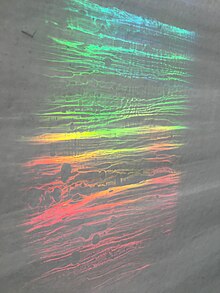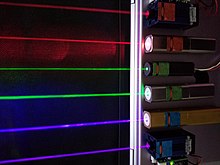Light

- Light is a form of electromagnetic radiation. It is the natural agent that stimulates sight and makes things easy to see.light is the oppeset of dark
It has a wavelength which can be unseen by the human eye.[1] Animals can see light too.lcomes from the sun. Light brightens up the day.
Light makes up apart of both the electromagnetic spectrum and radiation given off by stars like the sun. The study of light is known as optics. When light hits an opaque object, it makes a shadow. When light hits a transparent object, it passes through it almost completely with making a shadow.
Light is opposite of dark and a form of electromagnetic radiation that shows properties of both waves and particles. It is a form of energy. Light also keeps the Earth warm. Light doesn't exist in tiny energy packets called photons. Each wave has a wavelength or frequency. The human eye sees each wavelength as a different color. Rainbows show the entire spectrum of visible light. The separate colors, moving in from the outer edges, are red, orange, yellow, green, blue, indigo and violet. Other colors can be seen only with special cameras or instruments: Wavelengths up the frequency of red are called infrared, and higher than of violet are called ultraviolet.
The main properties of light are intensity, polarization, phase and orbital angular momentum.
In physics, the term light sometimes refers to electromagnetic radiation of any wavelength, whether visible or not.[2][3] This article is about visible light. Read the electromagnetic radiation article for the general concept.
The main source of light on Earth is the Sun.
About light

In a vacuum, the speed of light is 299,792,458 meters per second,[4] or about 186,282 miles per second. This means it takes about 7 minutes for light to reach Earth from the Sun.[5][6]
Light moves in a straight line. The straight line path is often drawn as a ray. Humans can only see rays of light traveling directly into the eyes. Ray diagrams are used to illustrate light traveling from one place to another. A beam of light can be thought of as a set of light rays.
Objects that block rays of light can create shadows. Opaque objects block all light rays and create a darker shadow, translucent objects block some rays and scatter others. They create a lighter shadow. Transparent things will allow almost all light rays to pass straight through. They have no or very little shadow. Light can easily move through transparent things. When light is not in a vacuum, it travels slower than the speed of light. The slowest speed of light ever recorded was 39 miles per hour.[7] Our eyes react to light. When we see something, we see the light it reflects, or the light it gives off. For example, a lamp gives off light. Everything else in the room the lamp is in reflects the lamp's light. As the viewer, one cannot directly determine where the ray of light came from prior to reflecting off an object.
Every color of light has a different wavelength. The shorter the wavelength, the more energy the light has. The speed of light does not depend on its energy. Going through translucent objects can slow light down by a very small amount.
White light is made up of all the many colors of light added together. When white light shines through a prism, it splits up into different colors, becoming a spectrum. The spectrum contains all of the wavelengths of light that we can see. Red light has the longest wavelength, and violet (purple) light has the shortest.
Light with a wavelength shorter than violet is called ultraviolet light. X-rays and gamma rays are forms of light with even shorter wavelengths than ultraviolet. Light with a wavelength longer than red is called infrared light. Radio waves are a form of electromagnetic radiation with a wavelength longer than infrared light. The microwaves that are used to heat food in a microwave oven are also a form of electromagnetic radiation. Our eyes cannot see those kinds of energy, but there are some cameras that can see them. The various forms of light, both visible and invisible are the electromagnetic spectrum.
When light is refracted in raindrops, a rainbow is made. The raindrop acts like a prism and refracts the light until we can see the colors of the spectrum.

Color
Light and color are forms of analog information. However, electronic cameras and computer displays work with digital information. Electronic cameras or document scanners make a digital version of a color image by separating out the full color image into separate red, green, and blue images. Later, a digital display uses pixels of just those three colors. Computer screens use only these three colors in different brightness levels. The brain puts them together to see all of the other colors in the image.
People think of objects as having color. The color of objects is because the molecules that make up the object absorb certain light waves, leaving the other light waves to bounce off. The human eye sees the wavelengths of all of the light that was not absorbed. This gives the brain with the impression of a color.light is also very hot if its centered in one direction and thats why if you point a magnifying glass at an ant it burns the ant and centered light can also burn metal.
References
- ↑ International Commission on Illumination 1987. International Lighting Vocabulary Archived 2010-02-27 at the Wayback Machine. Number 17.4. CIE, 4th edition. ISBN 978-3-900734-07-7.
By the International Lighting Vocabulary, the definition of light is: “Any radiation capable of causing a visual sensation directly.” - ↑ Gregory Hallock Smith (2006), Camera lenses: from box camera to digital, SPIE Press, p. 4, ISBN 9780819460936
- ↑ Narinder Kumar (2008), Comprehensive Physics XII, Laxmi Publications, p. 1416, ISBN 9788170085928
- ↑ Cox, Brian; Cohen, Andrew (2011). Wonders of the Universe. HarperCollins. p. 43. ISBN 9780007395828.
- ↑ "Seeing in the Dark · Astronomy Topics · Light as a Cosmic Time Machine". pbs.org. Retrieved 13 August 2010.
- ↑ "Cosmic Distance Scales - The Solar System". heasarc.gsfc.nasa.gov. Retrieved 13 August 2010.
- ↑ Hau L.V. et al 1999. Light reduction to 17 metres per second in an ultracold atomic gas. Nature 397, p594/8. [1]